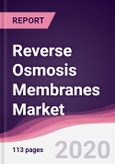The growth of the industrial, residential, and commercial sectors is the major driving factor for the growth of the reverse osmosis membrane market as they are the largest end user segments incorporating the RO membrane technology. Reverse Osmosis membranes have the capability to extract dissolved impurities and unfilterable molecules, which makes them appropriate for use in a wide number of end user applications. The Reverse Osmosis Membrane Market is estimated to grow at a CAGR of 10.15% during the forecast period = 2020–2025. The APAC Reverse Osmosis Membrane Market is forecast to grow at a highest CAGR of 12.85% during the forecast period towing to the rapidly growing infrastructure sector in developing countries such as China, Japan, India and South Korea; and the huge population base in these countries.
Reverse Osmosis Membrane Market Outlook
Reverse Osmosis (RO) is a technology that removes a large majority of contaminants from water by pushing the water under pressure through a semi-permeable membrane. It is a process where a weaker saline solution tends to migrate towards the strong saline solution. Reverse Osmosis Membranes consist of three layer composites, namely polyester support web, micro porous polysulfone inner layer, and thick polyamide barrier layer. The major material types of Reverse Osmosis Membranes encompassed in the scope of this report includes cellulose-based membranes and thin film composite membranes.
According to findings, the thin film composite membrane segment will hold the largest market share during the forecast period. The segment is estimated to grow at a CAGR of 11.38% and account for 79% of the total market share during the forecast period 2020–2025.
Reverse Osmosis Membrane Market Growth Drivers
The factors responsible for the growth of the RO Membrane market include the increasing awareness about health among people and the desire to avoid waterborne diseases. In recent times, domestic bottled water brands have faced threats as national regulators raise concerns about non-compliance with standards. According to a survey by the Ministry of Water Resources, China, more than 80% of the water from underground wells in China is not safe for drinking or bathing due to severe water pollution.
Reverse Osmosis Membrane Market Challenges
The loss of essential minerals from water owing to the use of RO membranes is one of the challenges faced by the Reverse Osmosis Membranes market. Water can provide over 20% of our daily minerals. Removing minerals from water leads to high acidity levels. Demineralized water may cause acidosis, which is a major cause of degenerative diseases.
Reverse Osmosis Membranes Market
Reverse Osmosis Membrane Market Research Scope
The base year of the study is 2020, with forecast done up to 2025. The study presents a thorough analysis of the competitive landscape, taking into account the market shares of the leading companies. These provide the key market participants with the necessary business intelligence and help them understand the future of the Reverse Osmosis Membrane Market. The assessment includes the forecast, an overview of the competitive structure, the market shares of the competitors, as well as the market trends, market demands, market drivers, market challenges, and product analysis. The market drivers and restraints have been assessed to fathom their impact over the forecast period. This report further identifies the key opportunities for growth while also detailing the key challenges and possible threats. The key areas of focus include the types of Reverse Osmosis Membranes, and their specific applications in different end user industries.
Reverse Osmosis Membrane Market Report Industry Coverage
- Material Type in Reverse Osmosis Membranes: Cellulose Based Membranes and Thin Film Composite Membranes.
- Filter Modules in Reverse Osmosis Membranes: Plate and Frame, Spiral Wound Membranes, and Tubular Shaped Membranes.
- Applications of Reverse Osmosis Membranes: Residential and Commercial, Industrial, Healthcare and Medical.
The Reverse Osmosis Membrane Market report also analyzes the global region for the market.
The regions and countries covered in the study include:
- North America (U.S., Canada, and Mexico)
- Europe (U.K, Germany, France, Italy and Rest of Europe)
- Asia-Pacific (China, India, South Korea, Japan, and Rest of Asia-Pacific)
- Rest of World (South America, Middle East and Africa)
Reverse Osmosis Membrane Market Key Players Perspective: DowDuPont is a major player in the reverse osmosis membrane market holding a market. It held a market share of 32% in 2020. DowDuPont is followed by Toray Industries, Inc, and Nitto Denko (Hydranautics), which held a market share of 31% and 25% respectively in 2020.
- Nitto Denko Corporation has acquired one of the major reverse osmosis manufacturers. Hydranautics. Through this acquisition, Nitto Denko Corporation has become one of the key membrane manufacturers.
- Other major reverse osmosis membrane manufacturers include SUEZ Water Technologies & Solutions, and Toyobo.
Reverse Osmosis Membrane Market Trends
The global demand for RO membranes is estimate to grow by nearly 10.15% during the forecast period driven mainly by the developing economies. In 2020, Asia-Pacific accounted for nearly 42.10% of the overall Reverse Osmosis Membranes Market and this is anticipated to reach nearly 48.76% by 2025.
The Industrial segment held almost 52% of the market share in 2020. RO membranes are increasingly being used in the productive processes of numerous industries. Among the many factors responsible for the growth of the RO membrane market, increasing awareness about health among people and the desire to avoid waterborne diseases are the major factors.
Table of Contents
Methodology

LOADING...








